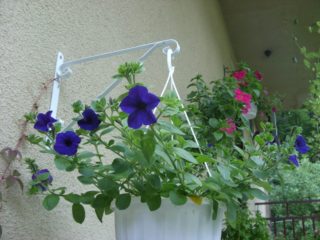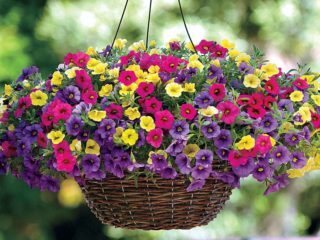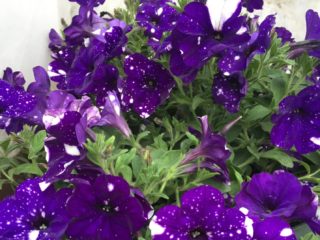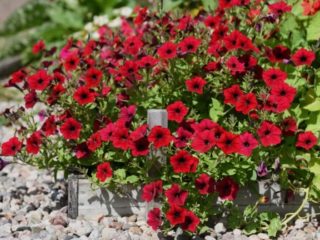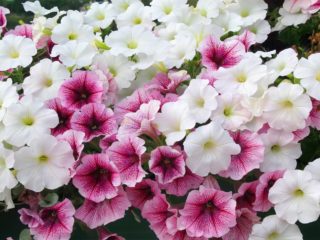Content
One of the types of vegetative flowers that do not propagate by seeds is petunia Stormy sky. It is a semi-ample plant with uniquely colored buds. The crop is characterized by fast growth, good branching, which allows the planter to be completely filled in a short time. A distinctive feature of the hybrid: the color of the flowers changes depending on the growing conditions.
Breeding history
The vegetative petunia Stormy Sky was bred in 2018 by German breeders working for Selecta Klemm GmbH & Co. In the same year, the culture collected all possible awards at the European Flower Exhibition. At the moment, flower growers know about 40 different types of petunias.
Description of petunia Thunderous sky and characteristics
All petunias belong to the Solanaceae family. In the wild, they can be found in the Americas. Uncultivated species grow up to 1 m in length.
Petunia The stormy sky is highly decorative. This compact plant, when planted in hanging pots, can produce long, meter-long, strong shoots. Petunia bushes well and grows, branching is abundant.
The buds form continuously from May to August, densely cover the entire plant. Leaves are light green, soft to the touch, velvety. They cover shoots densely, never exposing them. At this time, petunia Stormy sky becomes like a blooming ball of regular shape. In coverage, its size ranges from 35 to 50 cm.
With a lack of nutrients in the soil, green mass can prevail over flowering. The situation can be easily remedied by applying potash fertilizers.
Description of petunia Stormy sky is fully consistent with the photo. When buying a seedling from trusted growers, a flower lover will not be mistaken with his choice.
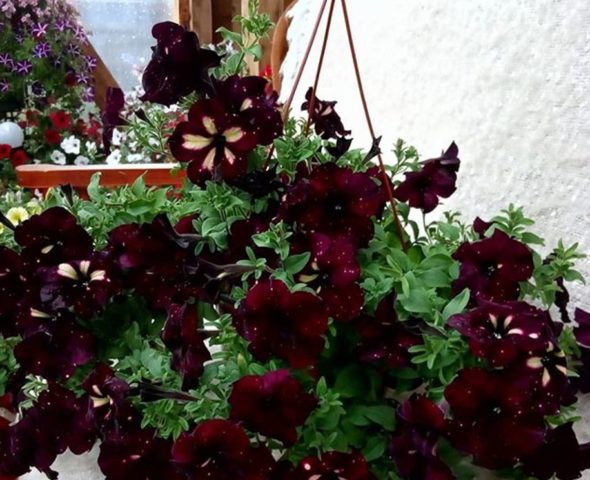
The first flowers of the Stormy sky are dark, almost black, over time, yellow rhombuses begin to form in the center
The buds are dark burgundy, cherry, crimson, with small white spots, bowl-shaped, their diameter can reach 8-10 cm. The petals are rounded, wide, there are 5 of them on the branch. White dots appear on the flowers when there is a large difference in night and day temperatures. If you grow a vegetative petunia Stormy sky in direct sunlight, cream spots appear more, merge, the buds become almost beige, with a dark border around the edge.

Under the influence of light, the central part of the petals brightens, petunia The stormy sky looks different
The color of each flower of the Stormy Sky hybrid is unique. One can be completely burgundy speckled, the other half yellow, the third almost black, velvet.
The culture is resistant to weather whims, does not stop blooming in 30-degree heat and with prolonged rains. With a strong cold snap in summer, it is better to put the flower pots in the greenhouse or bring it into the house. Petunia is not susceptible to diseases and attacks of pests.
Withered buds hide inside the plant, which looks decorative and without pruning.
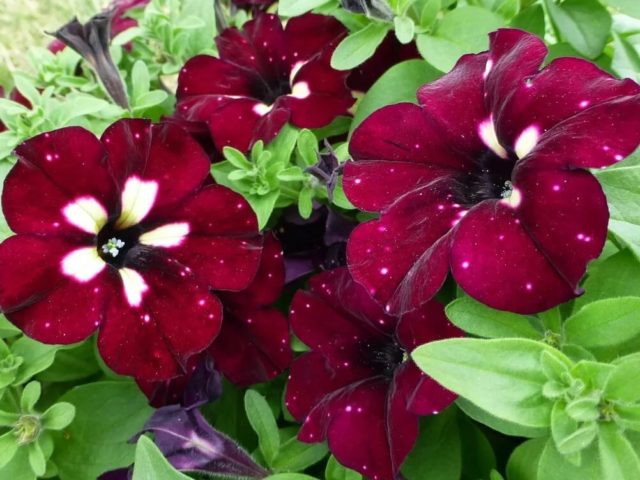
The seed pods do not tie on the shoots and do not spoil their appearance
Advantages and disadvantages of the variety
Negative qualities in petunia Stormy sky are practically not revealed. To obtain a contrasting color, it is necessary to maintain a significant difference between night and day temperatures. Ideally, this gap should be from + 10 in the evening to +30 ᵒC in the afternoon.
Benefits:
- good adaptability to any climate;
- unique color of buds;
- high decorativeness;
- long and continuous flowering;
- unpretentiousness;
- moderate watering;
- resistance to pests and diseases.
The crop can be grown in flower beds, balcony boxes, hanging pots and planters.
Reproduction methods
Petunia Stormy Sky is a hybrid that does not propagate by seeds. For growing crops, seedlings are purchased. At home, cuttings are separated from the mother bush.
For reproduction, last year's queen cells and young plants are used. Sprawling bushes with large flowers will do. They are brought into a cool room at the end of summer, the air temperature should be + 10-12 ᵒС.
Cutting petunia begins at the end of February. Cuttings 10 cm long are cut from the tops of the uterine bushes. A couple of upper leaves are left on them, and they are shortened by half.

Petunia Stormy sky is a capricious plant, it is difficult to propagate it, the experience is not always successful
Each cutting is placed in a root-forming solution, soaked for several hours. After that, the sprouts are deepened 4 cm into loose soil or sand. The distance between the seedlings is 2 cm. After planting, the cuttings are watered. Seedlings are covered with foil and placed on a well-lit windowsill.
The temperature in the room is maintained at least + 20 ᵒС. The seedlings are watered daily, additionally sprayed, the film is removed for half an hour for airing.
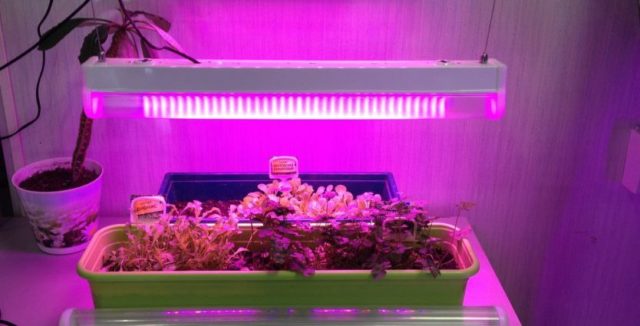
With the help of lamps, daylight hours are increased to 10 hours
After a week, the cuttings will have roots, after another 7 days the leaves will hatch. Petunia is transplanted into separate containers as soon as 2-4 true leaves develop in the sprout. Beforehand, the soil in the container is thoroughly moistened, a young plant is pryed with a stick, trying not to damage the root, and transferred to a separate peat cup. The container is filled with loose soil mixed with sand, the rules of care remain the same. Seedlings can not tolerate transshipment well. If the leaves begin to dry and wilt, they are sprayed with a spray bottle 2 times a day.
Growing and care
Petunia Thunderous sky grows well outdoors and in pots. Before planting on a flower bed in early spring, the flower is hardened by taking it out into the open air for an hour daily. Root seedlings as soon as the night frosts pass (second half of May).
Planting is carried out in loose, well-drained soil. Petunia loves sandy loam or clay soils. Previously, a solution of compost or humus is introduced into them, but the culture does not tolerate manure. This fertilization promotes the development of fungal colonies in the soil.
An hour before transplanting, the seedlings are spilled abundantly. As soon as the water is absorbed, the plants are removed from the pots along with the earthy clod.

When handling petunia seedlings, it is important not to injure the root processes
Making markings on the flowerbed, keep the distance between the bushes at least half a meter. A garden bed or container with seedlings is placed in a well-lit place, small, single flowers are formed in partial shade. It is important to protect petunia Stormy sky from winds and drafts.
After rooting, the plant is watered abundantly at the root, and the next day the soil is mulched. The buds can be removed, this will stimulate the formation of new ovaries.
The plant does not need special care. It is necessary to remove faded buds in a timely manner. In containers, petunias are watered as the soil dries out, less often in the open field. Be sure to loosen the soil regularly, do not allow excess moisture, the formation of a crust on the soil. If weeds germinate, they are uprooted.
From the beginning of spring until the end of budding, Petunia Stormy Sky is fed with water-soluble fertilizers for flowering crops. For these purposes, you can take nitrophoska, "Kemira", "Solution" and other complex mineral fertilizers.They are bred at the rate of 25 g per 10 liters of water or according to the instructions. Nutrients are introduced one week after rooting. The procedure is carried out every 14 days.
Pests and diseases
Petunia Stormy Sky is resistant to pests and diseases. During cultivation, the bottom of the cutting may suffer from "black leg". This happens when the air humidity is high. If sick seedlings are found, they are removed, the number of watering is reduced, and the seedlings are treated with fungicides.

Blackleg is a fungal disease that can completely destroy seedlings
If the leaves of petunia have turned yellow Stormy sky, the reason is the lack of nutrients, in the reduced or excessive acidity of the soil.
Application in landscape design
Hybrid Stormy sky is quite unpretentious, suitable for growing in all climatic zones of Russia. Petunias have long been used to decorate landscapes. In the yard, on flower beds and hanging pots, they look perfect: a rounded, spreading bush leaves no gaps, completely frames the pots.
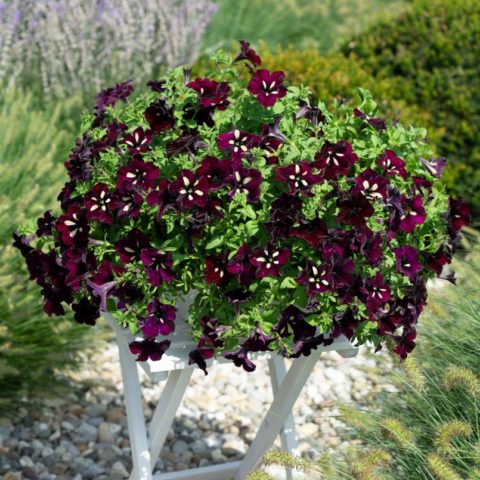
Portable petunia stands will fit well in a garden landscape with a gravel path
You can install a planter with petunias near the doorstep. They will perfectly decorate the entrance to the house.

Petunias look good.Stormy sky in pots on the outer window sills, framing white frames
The varieties Thunderous and Night Sky are perfectly combined. Several types of speckled petunias are planted in hanging pots.

New hybrids work well with each other, but there are not so many options for their use.
With the help of several types of petunias, you can literally transform a nondescript courtyard in the spring. Varieties with dark buds are combined with white-flowered and pink plants. Petunia seedlings are rooted in the flowerbed, seeds are not germinated in the open field.
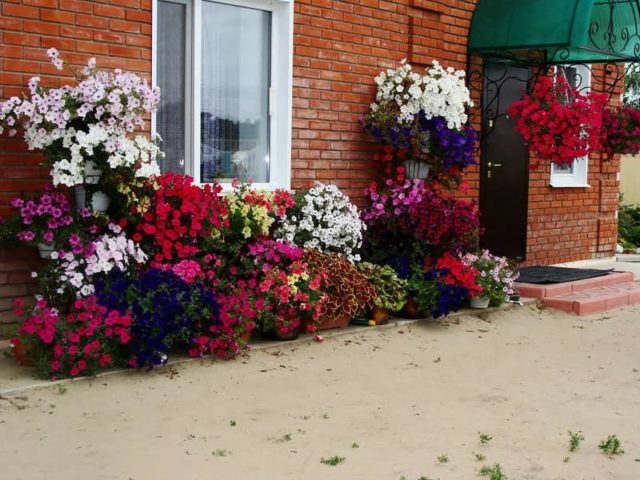
It is good to place the culture Thunderous sky under the windows, a subtle floral scent will hover in the yard and in the house
In floor vases and elongated containers for window sills and balconies, the Stormy Sky hybrid goes well with pelargonium, fuchsia, lobelia, sweet peas. In suspended structures, petunia is planted in combination with ivy, bacopa, viola, verbena.
Conclusion
Petunia Stormy sky has a unique color of buds, which changes depending on the conditions of detention. Each flower on a rounded, densely green plant is unique. The culture is suitable for growing outdoors and in pots. Abundant and long flowering from May to October attracts many florists; in a short time, the hybrid has become popular in many countries.
